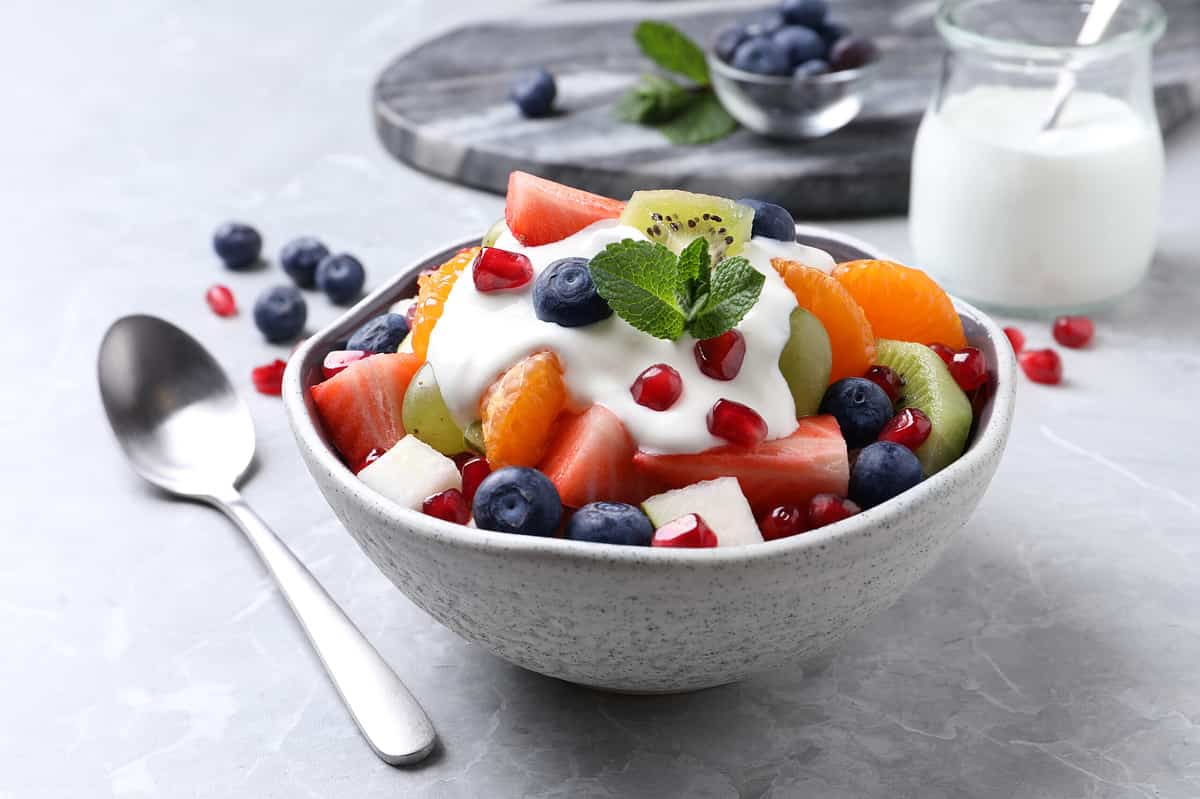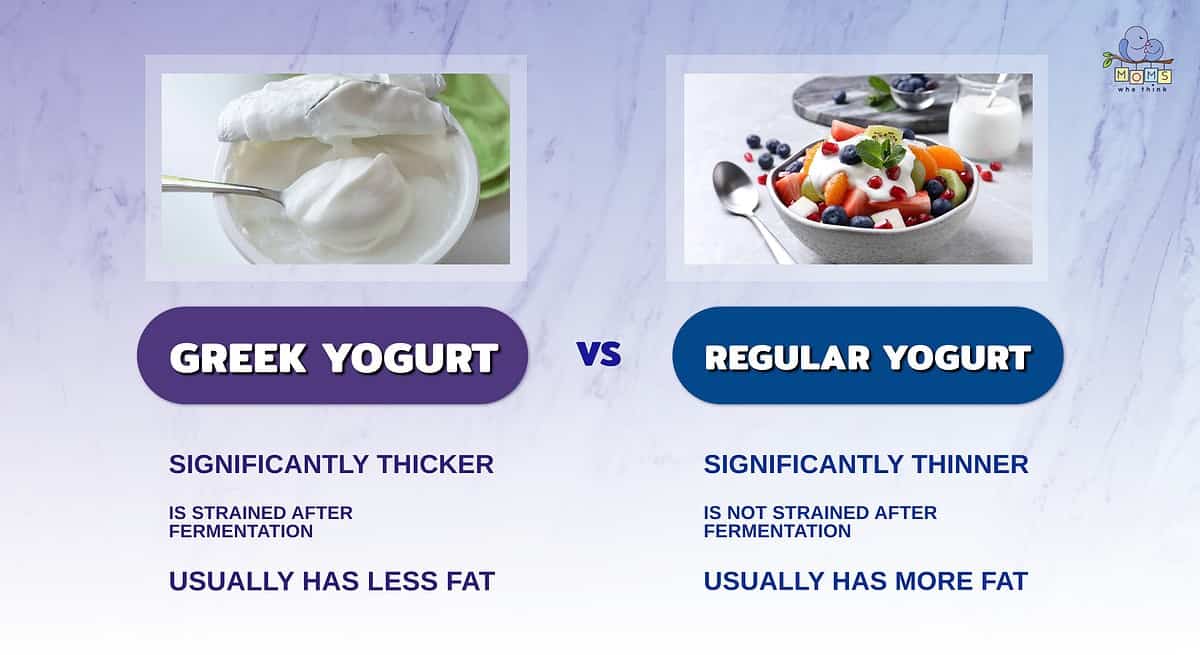Yogurt is a dairy product that we are all familiar with. Some people eat it straight, while others mix it with fruit, granola, almonds, or honey. It is a common ingredient in smoothies, salad dressings, savory dips, and even meat marinades. Yogurt is so adaptable that you may consume it as a frozen treat or use it in desserts and baked goods. However, there are two kinds of yogurt to pick from in the cool dairy aisle: Regular yogurt and Greek yogurt.
Most people understand that Greek yogurt is thicker and tarter, whereas normal yogurt is thinner and sweeter. But what causes them to taste the way they do? And, aside from flavor and texture, what differentiates them? Let's look at what makes them different, as well as their similarities and the various ways you can use them in your dishes.

Delicious fruit salad with yogurt, Greek or regular, is a healthy and filling breakfast or snack option.
©New Africa/Shutterstock.com
What is Greek Yogurt?
Greek yogurt is simply strained normal yogurt (made from cultured milk that has been fermented). Whey (the watery part of milk that remains after curds form) is progressively drained throughout this straining process, resulting in a significantly thicker consistency than conventional yogurt. This means it contains more protein and less sugar than most ordinary yogurts. There are full-fat variations, as well as low-fat and non-fat varieties available.
Greek yogurt (particularly the plain, full-fat variety) is ideal for sauces and dips, baking (it gives a pleasant, fluffy texture), and, of course, breakfast!
What is Ordinary Yogurt?
The main ingredient of yogurt is milk. Actually, yogurt is a milk fermentation product, and lactic acid is a product of the fermentation process. Companies later add other varieties of bacteria, as well as additional substances such as sweeteners and flavors to the yogurt. The finished product has a smooth, inviting consistency. Yogurt is frequently drinkable, but it can also be eaten with a spoon.
Yogurt comes in a variety of flavors and types, including Icelandic yogurt, low-fat yogurt, Greek yogurt, and fat-free yogurt. Yogurts of various brands are also available in the market. Because milk is the primary ingredient in yogurt, it is high in nutrients such as potassium, calcium, and protein. Yogurt has numerous health benefits, including improved digestion.
Anyone can have yogurt as a snack at any time of the day, or as a breakfast meal. Some people even eat fruits with their yogurt. We can even use yogurt to produce new sorts of meals and treats, such as smoothies.
What is the Difference Between Regular Yogurt and Greek Yogurt?
Both regular yogurt and Greek yogurt are cultured dairy products manufactured from milk, and they are actually quite similar.
Yogurt is made by fermenting milk with bacterial cultures. Fresh milk is pasteurized to kill bacteria before lactic bacteria starters (cultures) are introduced to start the fermentation process. After adding the cultures, the milk is held at a precise temperature to help speed up the bacterium activity, which converts lactose (the sugars naturally contained in milk) to lactic acid to thicken the milk and give yogurt its trademark tangy flavor.
Greek yogurt follows the exact same manufacturing process as conventional yogurt. Except that in the case of Greek yogurt, after fermentation, the yogurt undergoes a process of straining to get rid of the extra liquid whey (the watery component) and lactose (milk's sugar), resulting in a thicker-textured yogurt. This was, at least, the traditional procedure.
The traditional procedure sees producers strain Greek yogurt in bags made of cloth to get a creamy and thick texture; however, some current producers use various processes to attain the same result. Today, not all yogurt called “Greek yogurt” comes from following the conventional method. Some of the more affordable and processed forms of Greek yogurt get their thick texture through the addition of some other dry ingredients, thickening agents, or milk proteins. It's important to read the ingredients to be sure that you're consuming actual traditional Greek yogurt rather than the fake processed versions.
Key Differences
Both Greek yogurt and regular yogurt are products of milk and include live cultures, although they differ in several ways:
Texture:
Greek yogurt and regular yogurt have very different textures. Because of the straining procedure that removes the whey and water content, Greek yogurt is thicker and creamier than conventional yogurt and has a denser texture. As a result, the feel in the mouth is more robust and velvety.
Regular yogurt, on the other hand, is thinner and smoother in texture since it is not strained and includes more liquid. Regular yogurt has a runnier texture and varies in thickness depending on the brand or variety.
Greek yogurt has a texture comparable to cream cheese or sour cream, but regular yogurt has a more liquid-like feel.

Regular yogurt is thinner and pourable compared to Greek yogurt.
©Fascinadora/Shutterstock.com
Fat Content
Greek yogurt has a lower fat level than conventional yogurt, though this varies depending on the brand and kind of yogurt. This is because the straining procedure removes some of the fat content along with the liquid.
However, there are also Greek yogurt varieties available with varying fat levels. Full-fat Greek yogurt, for example, comes from whole milk and may include more fat than regular yogurt. Similarly, low-fat or non-fat Greek yogurt is manufactured from skim milk and contains less fat than ordinary yogurt.
If you are trying to cut back on fat, Greek yogurt may be an excellent option. However, it is always a good idea to read the nutrition label to determine the fat content of the specific brand and kind of yogurt.
Taste
Greek yogurt and regular yogurt have distinct flavor profiles, with Greek yogurt being creamier and tangier in general. This is because the straining procedure that makes Greek yogurt removes some of the whey and lactose, resulting in a more concentrated yogurt with a stronger flavor.
Regular yogurt, on the other hand, has a softer taste and a smoother texture as a result of its increased liquid content. Regular yogurt tastes different depending on the type and brand, although it is often less acidic and sour than Greek yogurt.
Some people enjoy the tangier flavor of Greek yogurt, while others prefer the softer flavor of regular yogurt. It all comes down to personal taste and how you intend to utilize the yogurt in dishes or as a snack.
Nutritional Value
Greek yogurt and regular yogurt have differing nutritional qualities, however, dieticians typically regard both as healthy options.
Greek yogurt contains more protein and fewer carbs than regular yogurt. The straining procedure used to manufacture Greek yogurt removes most of the lactose and watery whey, which gives a more concentrated yogurt with a higher protein content. This property makes Greek yogurt a popular choice for those who want to improve their protein intake while limiting their carbohydrate intake.
Regular yogurt, on the other hand, is often lower in protein and higher in carbs than Greek yogurt since it contains more liquid and less concentrated yogurt. It can be a wonderful source of minerals including calcium, vitamin D, and probiotics, which are good for gut health.
When comparing the two, Greek yogurt is generally thought to be more nutrient-dense than conventional yogurt, although the actual nutritional content should be determined by checking the nutrition label of individual varieties and brands of yogurt. Furthermore, certain flavored yogurts might be heavy in added sugars, which can reduce the total nutritional value of the product.
Uses
Both Greek yogurt and regular yogurt can be used in a variety of ways, but their distinct textures and flavors make them more suited for specific applications.
Because of its creamier and thicker texture, Greek yogurt can be used in place of cream cheese or sour cream in sauces and dips, as well as in baked goods and smoothies. It can also be used to top granola, fruit, or savory foods such as soups and stews.
The thinner texture of regular yogurt makes it perfect for use in smoothies or as a base for marinades or sauces. It can also be used in baking, however extra flour or other dry ingredients may be required to compensate for the higher liquid content. Regular yogurt is also a popular breakfast option, whether eaten alone or combined with granola and fruit.
Both varieties of yogurt can be nutritious snacks on their own, but it's important to read the nutrition label and ingredients to make sure you're buying a type that meets your dietary needs and preferences. Finally, while the purposes of Greek yogurt and regular yogurt can be relatively similar, the differences in texture and taste can affect which one is better suited for a specific recipe or application.
Can You Use Greek Yogurt Instead of Ordinary Yogurt?
Yes, you may use Greek yogurt in place of normal yogurt in most recipes, but there are a few considerations. Greek yogurt is thicker and creamier than conventional yogurt since its liquid component (whey) has been removed, resulting in a higher protein level.
Here are a few suggestions for using Greek yogurt instead of ordinary yogurt:
- Use plain Greek yogurt: In most recipes, plain Greek yogurt can be used in place of plain normal yogurt. Flavored Greek yogurt, on the other hand, may contain added sugars and other flavorings that may have an impact on the texture and taste of your dish.
- Adjust the amount of liquid: Because Greek yogurt is thicker than conventional yogurt, the amount of liquid in your recipe may need to be adjusted to compensate. If you're creating a salad dressing or smoothie, for example, you may need to add a little additional liquid to thin it down.
- Adjust the tanginess: Because Greek yogurt is tangier than regular yogurt, you may need to adjust the amount of vinegar, lemon juice, or other acidic components in your recipe to balance the flavor.
Switching to Greek yogurt instead of regular yogurt is a terrific method to increase the protein content of your meals while also adding smoothness. Simply keep these suggestions in mind and experiment as much as you can to get the ideal proportion for your dish!
Is Greek Yogurt the Same as Regular Yogurt?
Although both Greek yogurt and conventional yogurt are milk products and include live bacterial cultures, they differ in texture, nutritional content, and manufacturing procedure.
Regular yogurt is strained to get rid of the whey, resulting in a thicker, creamier yogurt with a higher protein level. Because the straining process removes part of the sugar and lactose, Greek yogurt is lower in carbs and higher in protein than conventional yogurt.
In contrast, fermenting milk with bacterial cultures forms regular yogurt. It has a thinner consistency and a tangy flavor, and it has less protein than Greek yogurt.
So, while Greek yogurt and regular yogurt are comparable, they are not the same. Each has a distinct nutritional profile and application in cooking and baking.
What Are Some Greek Yogurt Substitutes?
Because Greek yogurt has a particularly thick texture and sour flavor, finding a suitable substitute can vary depending on the recipe. Here are some alternatives to consider:
- Plain yogurt: In many recipes, regular yogurt can be used in place of Greek yogurt. Although it has a thinner texture and a somewhat distinct flavor, it has a comparable nutritional profile and can be used in dips, smoothies, marinades, and dressings.
- Sour cream: In recipes that call for acidic and creamy flavor, sour cream is an excellent substitute for Greek yogurt. It's also thick, so it's great for soups and tacos.
- Silken tofu: This is an excellent dairy-free and vegan alternative to Greek yogurt. It has a creamy and soft texture, a moderate flavor, and is a good source of protein. Blended with other ingredients, it can be used to produce smoothies, salads, dips, and sauces.
- Buttermilk: In baking recipes, buttermilk is a great substitute for Greek yogurt. It has a tangy flavor that you can add to cakes, pancakes, and bread to provide moisture and acidity.

Nobody can resist a healthy bowl of yogurty goodness!
©Africa Studio/Shutterstock.com
The Best Yogurt Substitutes
There are numerous options for substituting ordinary yogurt based on the recipe and the desired flavor and texture. Here are some suggestions:
- Greek yogurt: In most recipes, Greek yogurt can be used in place of ordinary yogurt. It has a thicker consistency and a tangy flavor, and it is high in protein.
- Sour cream: In recipes that call for a creamy texture and acidic flavor, sour cream can be used in place of ordinary yogurt. But because it has more fat than conventional yogurt, it may not be ideal for all recipes.
- Buttermilk: In baking recipes, buttermilk can be used in place of ordinary yogurt. It has a tangy flavor and you can add it to cakes, muffins, and bread to provide moisture and acidity.
- Coconut yogurt: This is a dairy-free and vegan alternative to conventional yogurt. It has a creamy texture and a somewhat sweet flavor and is a product of coconut milk.
- Soy yogurt: Another dairy-free and vegan alternative to regular yogurt is soy yogurt. It is prepared from soy milk and has a texture and flavor similar to regular yogurt.
Consider the recipe's specifications as well as the desired taste and texture when choosing a substitute for ordinary yogurt. To find the perfect substitute for your recipe, you may need to experiment with numerous ones.
A Quick Comparison of Greek Yogurt vs. Regular Yogurt

Greek yogurt is significantly thicker than regular yogurt, which makes it great for parfaits and similar dishes. Regular yogurt is often drinkable, due to its thinner consistency. Regular yogurt and Greek yogurt are both fermented, but only Greek yogurt is strained after fermentation. Greek yogurt typically has less fat than regular yogurt, but some kinds can actually have more fat. Always read the nutrition label before assuming a brand of Greek yogurt has less fat than a comparable brand of regular yogurt.
Which type of yogurt do you prefer?
Greek Yogurt Recipes to Try
Print
Blueberry Smoothie Using Greek Yogurt
Ingredients
- 1 Blueberry Greek Yogurt
- 1 Cup Frozen Berries
- 3/4 Cup water or milk
- 1/2 Banana
- Honey to taste (optional)
- Optional Protein additions: Chia Seeds, Oatmeal, Peanut Butter, or Almonds
Instructions
- Combine ingredients and blend.
Regular Yogurt Recipes to Try
The image featured at the top of this post is ©Yavdat/Shutterstock.com


